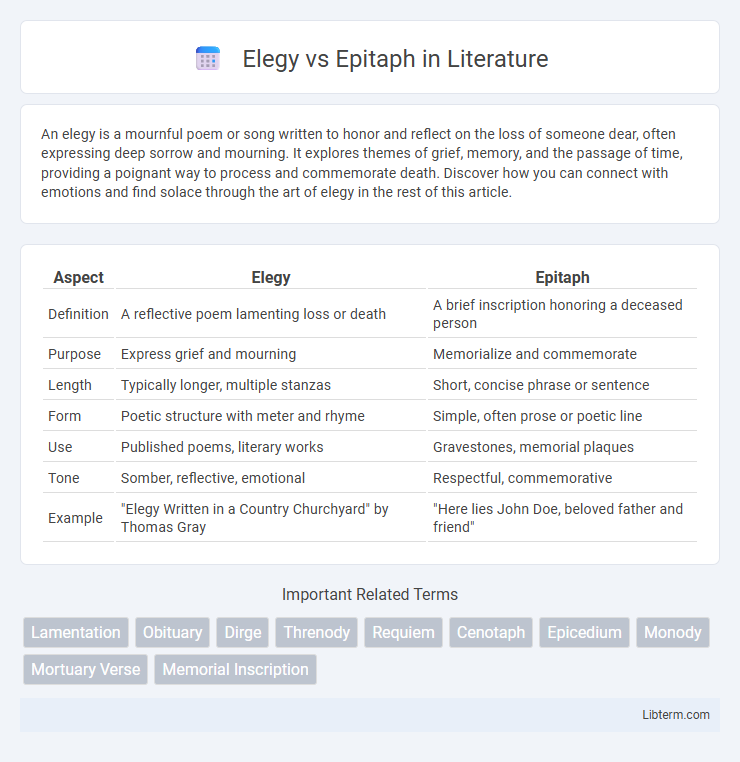An elegy is a mournful poem or song written to honor and reflect on the loss of someone dear, often expressing deep sorrow and mourning. It explores themes of grief, memory, and the passage of time, providing a poignant way to process and commemorate death. Discover how you can connect with emotions and find solace through the art of elegy in the rest of this article.
Table of Comparison
| Aspect | Elegy | Epitaph |
|---|---|---|
| Definition | A reflective poem lamenting loss or death | A brief inscription honoring a deceased person |
| Purpose | Express grief and mourning | Memorialize and commemorate |
| Length | Typically longer, multiple stanzas | Short, concise phrase or sentence |
| Form | Poetic structure with meter and rhyme | Simple, often prose or poetic line |
| Use | Published poems, literary works | Gravestones, memorial plaques |
| Tone | Somber, reflective, emotional | Respectful, commemorative |
| Example | "Elegy Written in a Country Churchyard" by Thomas Gray | "Here lies John Doe, beloved father and friend" |
Understanding Elegy: Definition and Purpose
An elegy is a reflective poem expressing sorrow or lamentation, typically mourning the death of an individual and providing emotional depth to loss. Its purpose is to offer solace, commemorate the deceased, and explore themes of mortality and grief through thoughtful, often melancholic, verse. Unlike an epitaph, which is a brief inscription on a tombstone, an elegy delves into personal reflection and universal human experiences surrounding death.
Decoding Epitaph: Meaning and Function
An epitaph is a concise inscription on a tombstone or monument that honors and memorializes the deceased, often capturing key aspects of their life or character. Functionally, epitaphs serve as a final tribute and a form of public remembrance, providing visitors with insight into the individual's legacy in just a few words. Unlike a lengthy elegy, which is a poetic lament expressing sorrow and reflection, an epitaph is succinct and designed to endure as a permanent marker of identity and memory.
Historical Origins of Elegies and Epitaphs
Elegies, originating in ancient Greek literature, were originally lyric poems expressing lamentation for the dead, often performed with a musical accompaniment. Epitaphs date back to ancient civilizations such as Egypt and Rome, serving as brief inscriptions on tombstones to commemorate the deceased. Both forms evolved to reflect cultural attitudes towards death and remembrance throughout history.
Key Differences Between Elegy and Epitaph
Elegies are extended poetic compositions that express mourning and reflect on loss, often exploring themes of grief and memorialization in a contemplative manner. Epitaphs, by contrast, are brief inscriptions engraved on tombstones or monuments that succinctly commemorate the deceased with dates, names, and sometimes a short message or quote. The key differences between elegy and epitaph lie in their length, format, and purpose: elegies provide a detailed emotional exploration of death, while epitaphs offer concise, factual remembrance.
Common Themes in Elegies
Elegies commonly explore themes of mourning, loss, and the passage of time, reflecting on the deceased's life and the impact of their absence. They often express sorrow, remembrance, and longing, emphasizing the emotional experience of grief. These poems typically serve as a meditative tribute, contrasting with epitaphs, which are brief inscriptions honoring the dead.
Distinctive Features of Epitaphs
Epitaphs are concise inscriptions carved on tombstones or monuments that commemorate the deceased, often encapsulating their identity, virtues, or achievements in a brief form. Unlike elegies, which are lengthy poetic compositions mourning loss and exploring grief, epitaphs serve as succinct memorials designed for public display and remembrance. Their distinctive features include brevity, permanence, and a focus on honorific or biographical details that provide lasting tribute at burial sites.
Notable Examples of Classic Elegies
Classic elegies such as John Milton's "Lycidas," Thomas Gray's "Elegy Written in a Country Churchyard," and W. H. Auden's "In Memory of W. B. Yeats" exemplify the traditional form of reflective mourning poetry that explores themes of loss, mortality, and remembrance. Unlike epitaphs, which are brief inscriptions on tombstones often commemorating a specific individual, elegies serve as extended meditations on death and the human condition. These renowned works have significantly influenced modern poetic expressions of grief and have been studied extensively for their rich metaphorical language and emotional depth.
Memorable Epitaphs from History
Epitaphs serve as concise tributes inscribed on tombstones, capturing the essence of a person's life or character in memorable phrases, such as Benjamin Franklin's "The Body of B. Franklin, Printer; Like the Cover of an Old Book, Its Contents Torn Out, And Stript of Its Lettering and Gilding, Lies Here, Food for Worms." Unlike elegies, which are lengthy poetic reflections mourning the deceased, epitaphs emphasize brevity and lasting impact, often becoming cultural touchstones in their own right. Famous epitaphs blend historical significance and literary artistry, immortalizing figures like William Shakespeare and Emily Dickinson in just a few words.
Elegy and Epitaph in Modern Literature
Elegies in modern literature serve as reflective poems mourning loss, often exploring personal grief and universal themes of mortality with emotional depth and introspection. Epitaphs, in contrast, are concise inscriptions on tombstones or memorial plaques that summarize the life or virtues of the deceased, functioning as brief commemorative texts. Contemporary usage of elegies emphasizes lyrical expression and subjective experience, while epitaphs maintain their traditional role as succinct, public memorials.
Choosing Between Elegy and Epitaph in Memorial Writing
Choosing between an elegy and an epitaph in memorial writing depends on the desired expression of grief and remembrance; elegies are poetic compositions that explore loss and mourning in depth, often reflecting personal emotions and universal themes. Epitaphs, in contrast, are concise inscriptions typically engraved on tombstones, summarizing a life or imparting a lasting message. Writers selecting between these forms should consider whether they want a reflective, extended tribute (elegy) or a brief, enduring tribute (epitaph) that encapsulates the essence of the deceased.
Elegy Infographic

 libterm.com
libterm.com